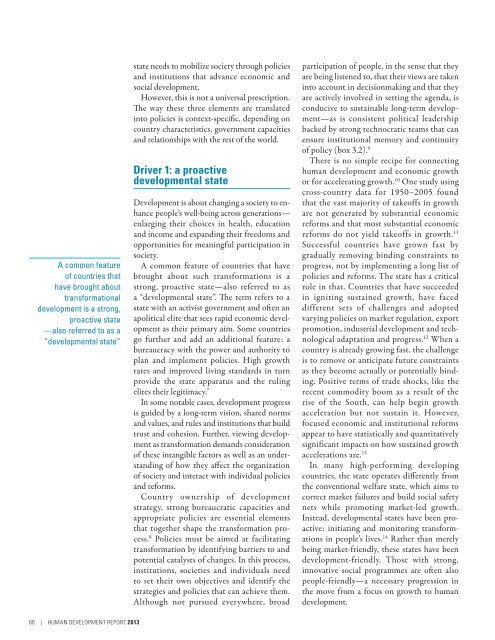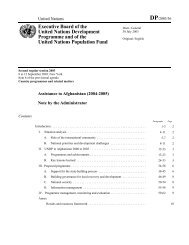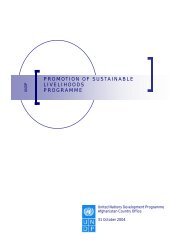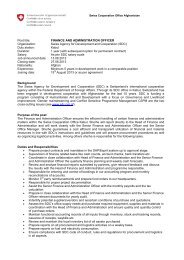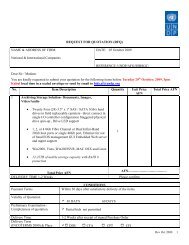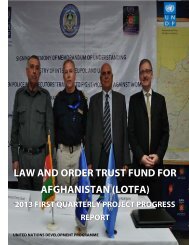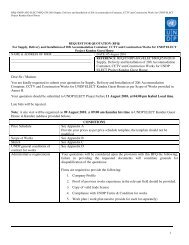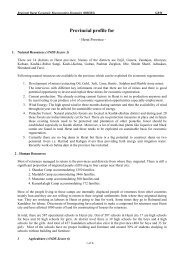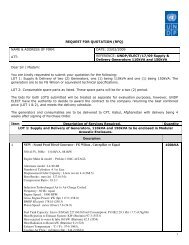E N S W - Human Development Reports - United Nations ...
E N S W - Human Development Reports - United Nations ...
E N S W - Human Development Reports - United Nations ...
Create successful ePaper yourself
Turn your PDF publications into a flip-book with our unique Google optimized e-Paper software.
A common feature<br />
of countries that<br />
have brought about<br />
transformational<br />
development is a strong,<br />
proactive state<br />
—also referred to as a<br />
“developmental state”<br />
state needs to mobilize society through policies<br />
and institutions that advance economic and<br />
social development.<br />
However, this is not a universal prescription.<br />
The way these three elements are translated<br />
into policies is context-specific, depending on<br />
country characteristics, government capacities<br />
and relationships with the rest of the world.<br />
Driver 1: a proactive<br />
developmental state<br />
<strong>Development</strong> is about changing a society to enhance<br />
people’s well-being across generations—<br />
enlarging their choices in health, education<br />
and income and expanding their freedoms and<br />
opportunities for meaningful participation in<br />
society.<br />
A common feature of countries that have<br />
brought about such transformations is a<br />
strong, proactive state—also referred to as<br />
a “developmental state”. The term refers to a<br />
state with an activist government and often an<br />
apolitical elite that sees rapid economic development<br />
as their primary aim. Some countries<br />
go further and add an additional feature: a<br />
bureaucracy with the power and authority to<br />
plan and implement policies. High growth<br />
rates and improved living standards in turn<br />
provide the state apparatus and the ruling<br />
elites their legitimacy. 7<br />
In some notable cases, development progress<br />
is guided by a long-term vision, shared norms<br />
and values, and rules and institutions that build<br />
trust and cohesion. Further, viewing development<br />
as transformation demands consideration<br />
of these intangible factors as well as an understanding<br />
of how they affect the organization<br />
of society and interact with individual policies<br />
and reforms.<br />
Country ownership of development<br />
strategy, strong bureaucratic capacities and<br />
appropriate policies are essential elements<br />
that together shape the transformation process.<br />
8 Policies must be aimed at facilitating<br />
transformation by identifying barriers to and<br />
potential catalysts of changes. In this process,<br />
institutions, societies and individuals need<br />
to set their own objectives and identify the<br />
strategies and policies that can achieve them.<br />
Although not pursued everywhere, broad<br />
participation of people, in the sense that they<br />
are being listened to, that their views are taken<br />
into account in decisionmaking and that they<br />
are actively involved in setting the agenda, is<br />
conducive to sustainable long-term development—as<br />
is consistent political leadership<br />
backed by strong technocratic teams that can<br />
ensure institutional memory and continuity<br />
of policy (box 3.2). 9<br />
There is no simple recipe for connecting<br />
human development and economic growth<br />
or for accelerating growth. 10 One study using<br />
cross-country data for 1950–2005 found<br />
that the vast majority of takeoffs in growth<br />
are not generated by substantial economic<br />
reforms and that most substantial economic<br />
reforms do not yield takeoffs in growth. 11<br />
Successful countries have grown fast by<br />
gradually removing binding constraints to<br />
progress, not by implementing a long list of<br />
policies and reforms. The state has a critical<br />
role in that. Countries that have succeeded<br />
in igniting sustained growth, have faced<br />
different sets of challenges and adopted<br />
varying policies on market regulation, export<br />
promotion, industrial development and technological<br />
adaptation and progress. 12 When a<br />
country is already growing fast, the challenge<br />
is to remove or anticipate future constraints<br />
as they become actually or potentially binding.<br />
Positive terms of trade shocks, like the<br />
recent commodity boom as a result of the<br />
rise of the South, can help begin growth<br />
acceleration but not sustain it. However,<br />
focused economic and institutional reforms<br />
appear to have statistically and quantitatively<br />
significant impacts on how sustained growth<br />
accelerations are. 13<br />
In many high-performing developing<br />
countries, the state operates differently from<br />
the conventional welfare state, which aims to<br />
correct market failures and build social safety<br />
nets while promoting market-led growth.<br />
Instead, developmental states have been proactive:<br />
initiating and monitoring transformations<br />
in people’s lives. 14 Rather than merely<br />
being market-friendly, these states have been<br />
development-friendly. Those with strong,<br />
innovative social programmes are often also<br />
people-friendly —a necessary progression in<br />
the move from a focus on growth to human<br />
development.<br />
66 | HUMAN DEVELOPMENT REPORT 2013


